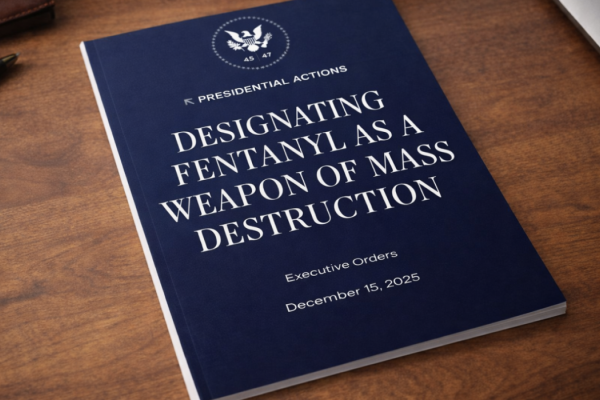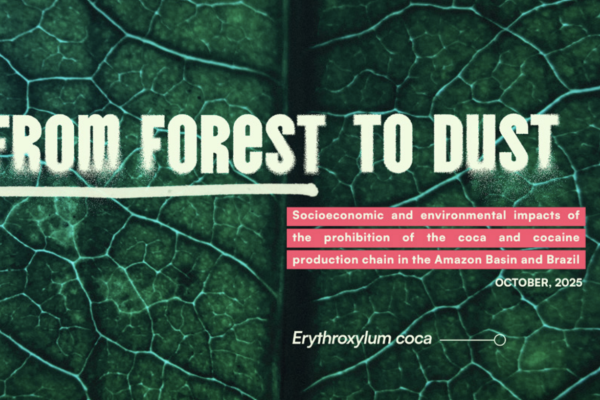7th March 2022
Download the pdf version of this briefing here
KEY POINTS
- The Misuse of Drugs Act 1971 is 50 years old but has never been subject to a formal government evaluation or review.
- More than three million criminal records have been issued under the Misuse of Drugs Act, with people sentenced to more than 680,000 years in prison since 1986.
- Drug use has risen dramatically, while drugs have become cheaper, more potent and more available.
INTRODUCTION
The Misuse of Drugs Act 1971 (MDA) underpins all UK drug policy, establishing criminal offences for a range of activities including possession, supply and production of specified ‘controlled drugs’. It brought the UK into line with the global prohibition regime established under the UN Single Convention on Drugs of 1961 (which the UK ratified). The MDA also established the Advisory Council on the Misuse of Drugs, and set out powers for the police to stop and search individuals on suspicion of drug possession.
Over the last five decades, vast financial and police resources have been directed towards enforcement of the MDA, while drug consumption, health harms and deaths have increased dramatically. The UK’s illegal drug markets - and associated criminality - have expanded to meet this growing demand, now valued at £9 billion annually [1]. Yet, despite the evidence that the MDA has strikingly failed in its primary aims of reducing drug availability, use, and health harms, this legislation has never been subject to formal government evaluation or review, and no meaningful evaluation framework has been established to report on, or scrutinize, outcomes.
This report presents a summary of key available data on which to assess the effectiveness, in terms of costs and impacts, of the UK’s Misuse of Drugs Act 1971, covering: criminalisation and incarceration; enforcement spending; drug-related deaths; prevalence of drug use; and drug availability.
Behind these statistics lie human stories: To learn how peoples’ lives have been impacted by the UK’s drug laws, please visit anyoneschild.org.
MILLIONS CRIMINALISED AND IMPRISONED
Under the MDA punitive enforcement has dominated the response to what has always primarily been a public health challenge. This has meant that over the last 50 years millions of people have had their life opportunities adversely impacted by criminalisation and imprisonment.
- More than three million criminal records have been generated across the UK for drugs offences over the MDA’s lifetime: 1.9 million guilty sentences in court; 1.3 million recorded police cautions for drugs offences (police cautions form part of a criminal record and are flagged in certain criminal record background checks) [2].
- Since 1986 people in the UK have been sentenced to 680,000 years in prison for offences under the MDA (the total figure for the last 50 years is assumed to be higher as sentencing data is only available post-1986, and only for some regions) [3].
- 16% of the prison population in England and Wales are sentenced for drug offences. If offending related to drug use is included, this proportion rises to 38% [4]. In Scotland and Northern Ireland 9.9% and 7.2% of the prison population respectively are sentenced for drug offences [5].
- Since 2010 more than 80% of all drug offences recorded by police have been minor possession offences [6].
- ‘Possession of cannabis’ has consistently been the most commonly recorded drug offence, making up more than two-thirds of all drug offences in 2019/20 [7].
- The proportion of stops and searches targeting drug offences in England and Wales has doubled from one-third in 2000, to nearly two-thirds in 2020, with only 10% of these leading to arrest in 2020 [8].
- Since 2000 more than 9.5 million stops and searches have been carried out for drugs by police forces across the UK [9].
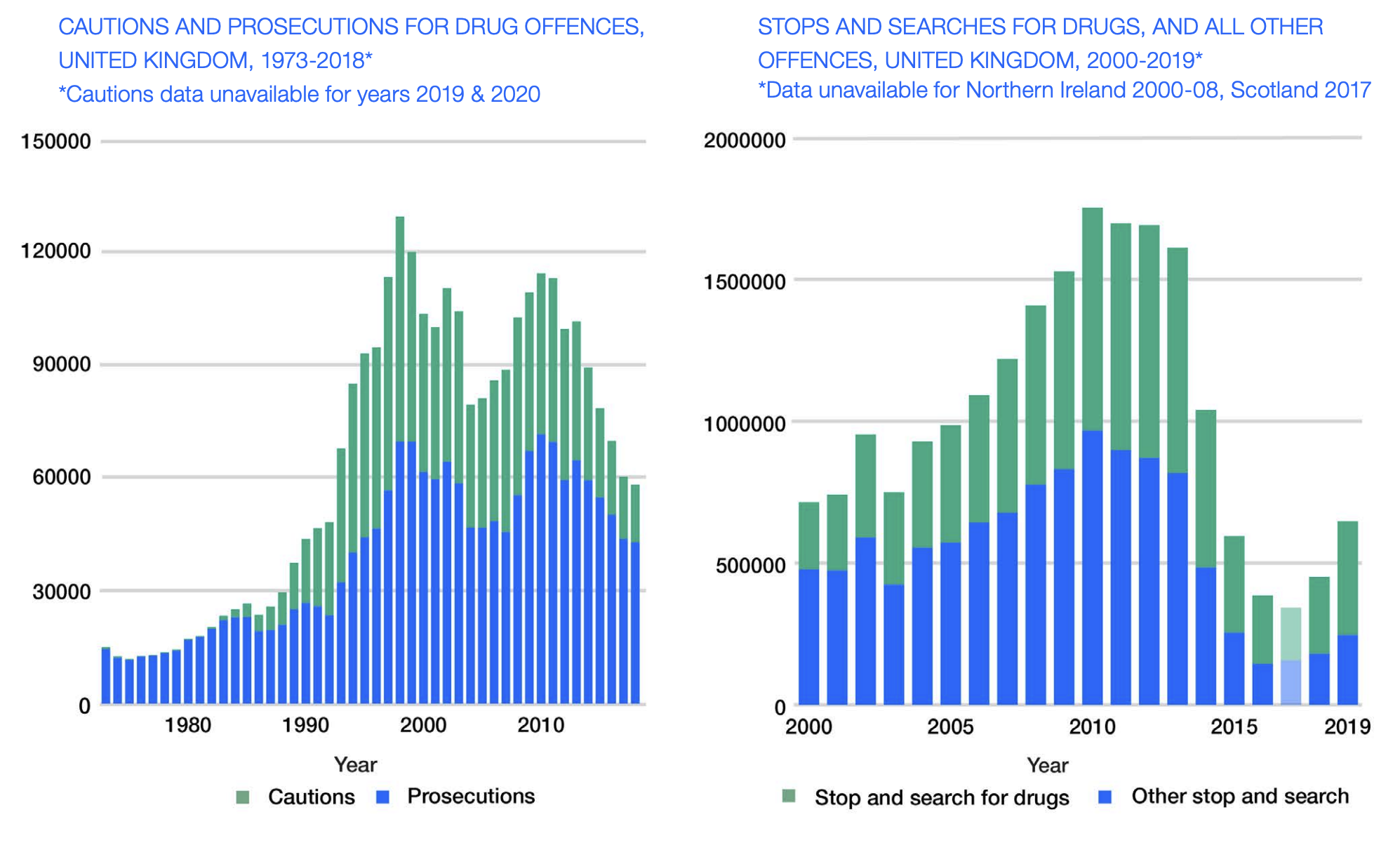
BILLIONS WASTED ON FAILED ENFORCEMENT
£6.9 billion a year is spent across the criminal justice system in England alone on dealing with drug offences and drug-related crime fuelled by the illegal trade (a UK-wide figure is not available). This spending is not subject to any routine evaluation of cost-effectiveness [10].
- £1.4 billion is spent annually enforcing drug laws in England alone, with £690 million spent on drug-related police enforcement costs, and an additional £733 million across the criminal justice system (courts, prisons, probation etc) [11].
- An additional £5.5 billion is spent annually in England alone, on the criminal justice costs of drug-related crime (including acquisitive property crime to fundraise to buy illegal drugs) according to the Government’s recent Independent Review of Drugs [12].
ENTRENCHED RACIAL DISPROPORTIONALITY IN DRUG POLICING
Minority groups, and in particular young Black males, have long been subject to disproportionate levels of drug-related police stop and search, arrest and prosecution on arrest. Data from earlier in the life of the MDA is not available, but more contemporary data paints a clear picture of the extent of this long-standing problem.
- Black people were 8.3 times more likely to be stopped and searched for drugs than white people in 2019/20 (but use drugs at similar or lower rates) [13].
- Black people in England and Wales made up 16% of all stops and searches for drugs in 2019/20, despite making up only 3% of the population [14].
- Black people are eight times more likely than white people to be prosecuted for drug offences post-arrest [15].
- Black and Asian people were convicted of cannabis possession at 11.8 and 2.4 times the rate of white people respectively. 25% of those convicted of cannabis possession are Black [16].
A RISING TIDE OF AVOIDABLE DRUG-RELATED DEATHS
The starkest indicator of the UK’s failing drug policy is drug-related deaths, which have risen dramatically over the lifetime of the MDA, particularly in the 1990s, and again since 2011.
- In England and Wales there were around 100 drug-related deaths recorded in 1971. In 2020 there were 2,996 [17].
- There were 4,553 drug-related deaths across the UK in 2020, more than tripling from 1,218 in 1994 [18].
- The UK drug-related death rate is 4.5 times the EU average, while Scotland’s is more than 16 times the EU average [19].
- Scotland’s drug-related deaths have increased 6-fold since 1994 from 244 deaths to 1,339, reaching record numbers for the eighth year in a row in 2020 [20].
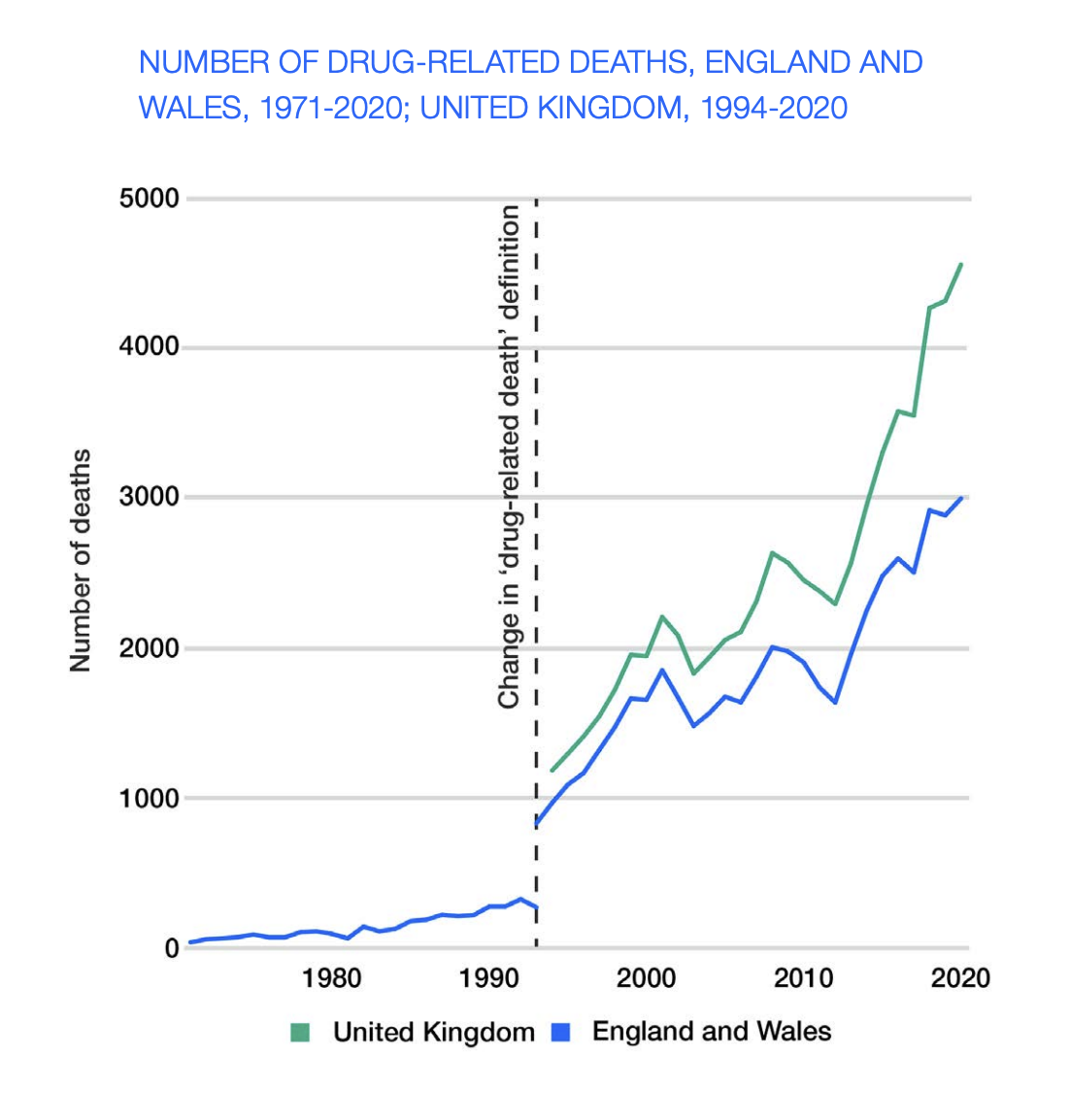
INCREASING LEVELS OF DRUG USE
A key aim of the MDA has been to reduce levels of illegal drug use through enforcement, targeting both people who use drugs and illegal drug supply. However, over the course of the past 50 years, levels of drug use have risen dramatically. Drug use in the UK is the highest of any country in Western Europe.
- In England alone, the number of people using heroin has risen from under 10,000 in 1971 to 260,000 today. This represents a more than 25-fold increase [21].
- Since 1971 cannabis use has increased by more than 5-fold, with more than 2.5 million people in England and Wales using cannabis in 2019 [22]
- By 2019, three million people used drugs in England and Wales, including almost one million people who used cocaine [23].
- Annual MDMA (ecstasy) use rose from zero in the mid-1980s to half a million people in 2019, this is despite MDMA being classified as a Class A substance since 1977 [24].
- The annual prevalence of any illegal drug use in Scotland has risen from 9% in 1996 to 13.5% in 2019 [25].
DRUG SEIZURE ‘SUCCESSES’ OBSCURE LONG-TERM FAILURE TO REDUCE AVAILABILITY
Substantial police, customs and military resources have been deployed to interdict drug supply both domestically and internationally in attempts to reduce the availability of drugs. Drug seizures are routinely celebrated by police and politicians as ‘preventing drugs from reaching the streets’. Despite the centrality of availability reduction in enforcement narratives and successive drug strategies, no formal availability measures have ever been established, collected or published [26]. However, in contrast to the proclaimed success related to seizures, data showing falling prices and rising purity all point to a reality of rising availability.
• Drug seizure trends are volatile and hard to interpret, but have tended to track, rather than impact on, prevalence of use. Seizures of cannabis, heroin and cocaine all follow a similar trend, having increased significantly between 1990 and the early 2000s, and subsequently decreased. However, the quantity of cocaine seized has risen again since 2011.
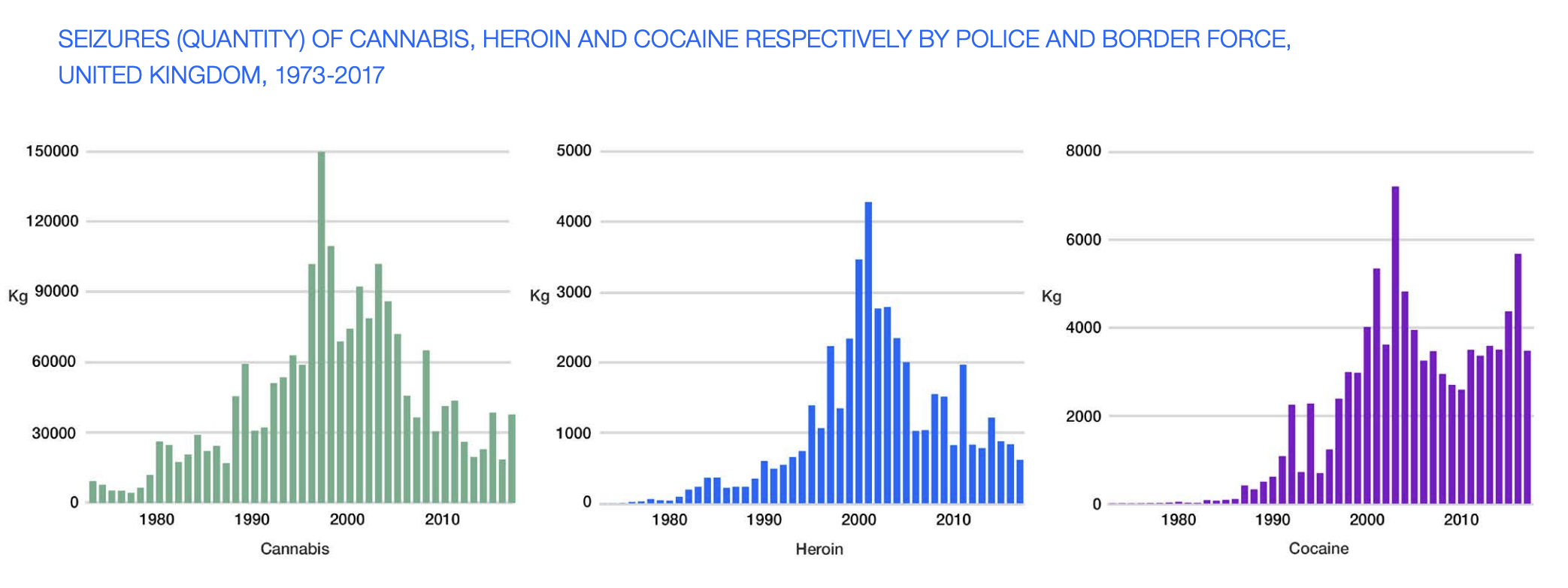
INCREASING DRUG AVAILABILITY, RISING POTENCY, AND FALLING PRICE
The data on drug price and potency has been inconsistently gathered or made available in the UK. EU data, however, provides a clearer picture of how the regional markets, within which the UK remains a key actor, have shifted over the past decade - with a trend towards rising potency, which increases risk, paired with stable or falling price, which increases affordability.
• Across Europe, MDMA content in ecstasy pills and THC content in cannabis (THC is the main psychoactive compound) has more than doubled since 2009, while prices remain relatively unchanged [27].
• Between the mid-1970s and mid-90s, the UK price of cocaine fell by between two-thirds and three quarters [28].
• Between 1990 and 2004 the average cocaine purity from police seizures in the UK fluctuated around 50%. In 2009 purity fell to a low of 20% before increasing to the highest level on record in 2018 at 63% [29].
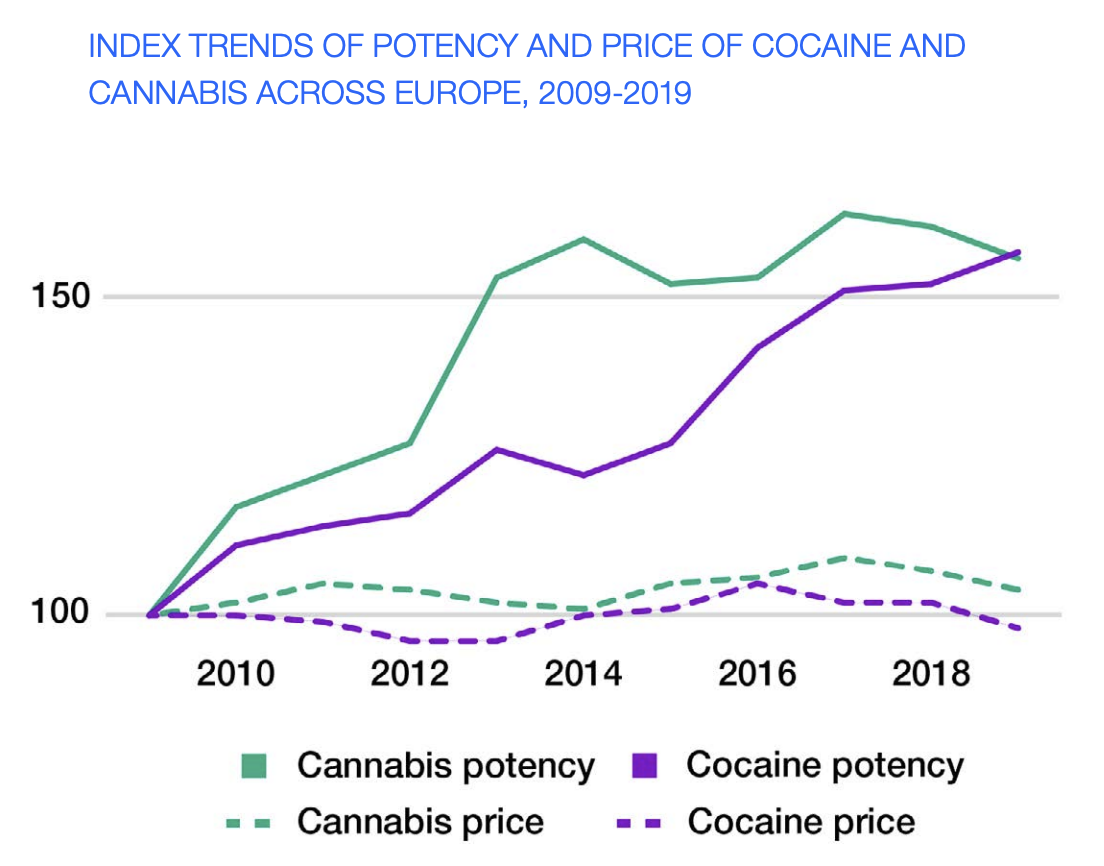
REFERENCES
[1] Home Office (2020). Review of Drugs: Executive Summary. p.5. https://assets.publishing.service.gov.uk/government/uploads/system/uploads/attachment_data/file/897786/2SummaryPhaseOne+foreword200219.pdf
[2] This figure includes both police cautions and prosecutions. Some data is missing, including cautions data for England and Wales for 2019 and 2020, cautions and prosecutions data for Northern Ireland and Scotland, 2003-2006 and 2007-2008 respectively. [Transform data available on request]
[3] This incomplete total figure includes United Kingdom 1986-1996; England and Wales 1997-2020; Scotland 1997-2019; data currently not available for Northern Ireland.
[4] Ministry of Justice; HM Prison Service (2021). Offender Management statistics quarterly: January to March 2021. https://www.gov.uk/government/statistics/offender-management-statistics-quarterly-january-to-march-2021; Home Office (2020). Review of Drugs, p.102.
[5] Scottish Government (2021). Scottish Prison Population Statistics: Legal Status, 2019- 2020. https://www.gov.scot/publications/scottish-prison-population-statistics-legal-status-2019-20/pages/6/; NISRA (2021). The Northern Ireland Prison Population 2020/21 https://assets.publishing.service.gov.uk/government/uploads/system/uploads/attachment_data/file/1018418/Northern-Ireland-Prison-Population-2020-21.pdf
[6] Shiner M., Carre Z., Delsol R., Eastwood N. (2018). The Colour of Injustice: ‘Race’, drugs and law enforcement in England and Wales p.10. StopWatch, LSE, Release. P.10. https://www.release.org.uk/sites/default/files/pdf/publications/The%20Colour%20of%20Injustice.pdf
[7] Commons Library Briefing (2020). Drug crime: Statistics for England and Wales. p.14. https://researchbriefings.files.parliament.uk/documents/CBP-9039/CBP-9039.pdf
[8] Transform data available on request
[9] Transform data available on request
[10] See for example: ACMD (2017). Drug strategy 2016: development review. https://www.gov.uk/government/publications/drug-strategy-2016-development-review; HM Government (2017) An evaluation of the Government’s Drug Strategy 2010 https://assets.publishing.service.gov.uk/government/uploads/system/uploads/attachment_data/file/628100/Drug_Strategy_Evaluation.PDF
[11] Data on enforcement costs is currently unavailable for Wales, Scotland and Northern Ireland. Home Office (2020). Review of Drugs - evidence relating to drug use, supply and effects, including current and future risks. p.16. https://assets.publishing.service.gov.uk/government/uploads/system/uploads/attachment_data/file/882953/Review_of_Drugs_Evidence_Pack.pdf
[12] Home Office (2020). Review of Drugs. Part 1 evidence pack p.16. https://assets.publishing.serv...
[13] HMICFRS (2021). Disproportionate use of police powers. p.30. https://www.justiceinspectorates.gov.uk/hmicfrs/wp-content/uploads/disproportionate-use-of-police-powers-spotlight-on-stop-search-and-use-of-force.pdf; Shiner, M., Carre, Z., Delsol, R., Eastwood, N. (2018). The Colour of Injustice: ‘Race’, drugs and law enforcement in England and Wales. StopWatch, LSE, Release. p.3.
[14] Home Office (2020). Police powers and procedures, England and Wales, year ending March 2020. https://www.gov.uk/government/statistics/police-powers-and-procedures-england-and-wales-year-ending-31-march-2020
[15] Shiner, M., Carre, Z., Delsol, R., Eastwood, N. (2018). The Colour of Injustice. p.viii. https://www.release.org.uk/sites/default/files/pdf/publications/The%20Colour%20of%20Injustice.pdf
[16] Shiner, M., Carre, Z., Delsol, R., Eastwood, N.(2018). The Colour of Injustice. p.42.
[17] Data for England and Wales pre-1994 is not directly comparable to the ONS standard definition of ‘drug misuse’ after this point, however it still provides a picture of the overall trend of drug-related deaths across the fifty years. Drug-related death data for 1971-1993 is taken from the 20th Century Mortality Files, using the more narrow definition of ‘drug dependence’. For 1971, the drug-related death figure is 38.
[18] ONS (2021). Drug-related deaths by local authority, England and Wales. https://www.ons.gov.uk/peoplepopulationandcommunity/birthsdeathsandmarriages/deaths/datasets/drugmisusedeathsbylocalauthority
[19] (Cases per million) EMCDDA (2021). European Drug Report 2021: Trends and developments. p.52. https://www.emcdda.europa.eu/publications/edr/trends-developments/2021_en; (Cases per million); ONS (2021). Drug-related deaths by local authority, England and Wales. https://www.ons.gov.uk/ peoplepopulationandcommunity/birthsdeathsandmarriages/ deaths/datasets/drugmisusedeathsbylocalauthority; NRS (2021). Drug-related Deaths in Scotland in 2020. https://
www.nrscotland.gov.uk/statistics-and-data/statistics/
statistics-by-theme/vital-events/deaths/drug-relateddeaths-in-scotland/2020; NISRA (2021). Drug-related and drug-misuse deaths 2009-2019. https://www.nisra.gov.uk/publications/drug-related-and-drug-misuse-deaths-2009-2019
[20] NRS (2021). Drug-related deaths in Scotland in 2020. https://www.nrscotland.gov.uk/statistics-and-data/statistics/statistics-by-theme/vital-events/deaths/drug-related-deaths-in-scotland/2020
[21] The Home Office Addicts Index; Home Office (2020). Review of Drugs. p.8.
[22] Hickman, M., Vickerman, P., Macleod, J., Kirkbride, J.; Jones P.B. (2007). Cannabis and schizophrenia: model projections of the impact of the rise in cannabis use on historical and future trends in schizophrenia in England and Wales; Home Office (2020). Review of Drugs. p.11.
[23] Home Office (2020). Review of Drugs. p.5; p.10.
[24] Crime Survey England and Wales (2020). Drug misuse in England and Wales: year ending March 2020. https://www.ons.gov.uk/peoplepopulationandcommunity/crimeandjustice/datasets/drugmisuseinenglandandwalesappendixtable
[25] Drug Misuse in Scotland: Findings from the 2000 Scottish Crime Survey. https://webarchive.nrscotland.gov.uk/20200116122421/https://www2.gov.scot/Publications/2002/05/14397/1180; Scottish Crime and Justice Survey, editions 2008/09-2019/20
[26] Seizure figures need to be interpreted with caution. They have had little or no impact on meaningful outcome measures of availability. See: Werb D., Kerr T., et. al. (2013). The temporal relationship between drug supply indicators: an audit of international government surveillance systems.
[27] EMCDDA (2021). European Drug Report 2021. p.17;p.24.
[28] Corkery, J. (2000). Snowed under: Is it the real thing? Druglink (May/June 2000) https://www.drugwise.org.uk/wp-content/uploads/cocaine-dossier.pdf
[29] Schifano, F., Corkery, J. (2008) Cocaine/crack cocaine consumption, treatment demand, seizures, related offences, prices, average purity levels and deaths in the UK (1990– 2004). Journal of Psychopharmacology 22(1) (2008) 71–79


